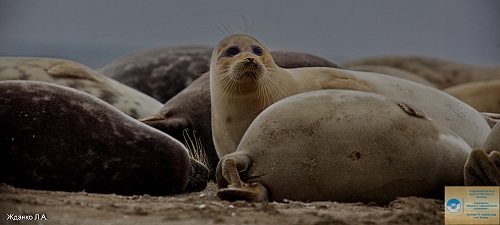← Back
Caspian seal ecology and conservation

By Lilia Dmitrieva, Simon J. Goodman, School of Biology, University of Leeds, UK
The Caspian seal (Pusa caspica) is a small-bodied, ice-breeding phocid, endemic to the landlocked Caspian Sea in Central Asia.
The species is listed as ‘Endangered’ by the International Union for the Conservation of Nature (IUCN), having declined by around
90% from a population exceeding 1 million individuals at the start of the 20th century, primarily due to unsustainable hunting.
It is now subject to a range of threats including high levels of mortality from fishing by-catch and other anthropogenic sources,
and habitat loss and disturbance caused by industrial and urban development. Little was known about its’ movement and dive
patterns, until a group of scientists from Estonia, Kazakhstan, Russia and the UK deployed 75 Argos satellite tags on Caspian
seals from 2009 to 2012. Their results, originally published in the Marine Ecology Progress Series, “Individual variation in seasonal
movements and foraging strategies of a land-locked, ice-breeding pinniped,” provide valuable data to support conservation efforts in the region.
Key findings

A Caspian seal about to be released after tagging with a Wildlife Computers SPOT tag.
Credit: Simon Goodman, University of Leeds
The historic observational view of Caspian seal movements was of a homogeneous migration with seals dispersing from northern moulting sites to the mid and southern Caspian via the east and west coasts from late April, followed by a return to the north Caspian from September (Badamshin 1969). Our data support the broad-scale seasonal movements reported in older literature, with a southerly shift in the median latitude of locations from May to September, coincident with increasing Sea Surface Temperatue (SST) and Net Primary Productivity (NPP), and a return north from October onwards (Fig. 1) as SST and NPP decline.
However, the Argos telemetry data revealed a high degree of individual variation in the timing, destination, and consistency of movement patterns, indicating that migratory movements are much more heterogeneous than previously thought. Movement during the winter was similarly heterogeneous.
In contrast to earlier assumptions, rather than staying in the ice pack for the whole season, animals made frequent return trips out of the ice, presumably to forage, with some ranging as far south as Kendirli. The longest track recorded over 11.5 months was more than 14,000 km and the deepest dives exceeded 200m and 20 minutes duration.
Read the adapted version of the article in the ArgosForum #83.
Read the original article in Marine Ecology Progress.
Learn more about Caspian seals on the IUCN Red List.
Watch the video:

